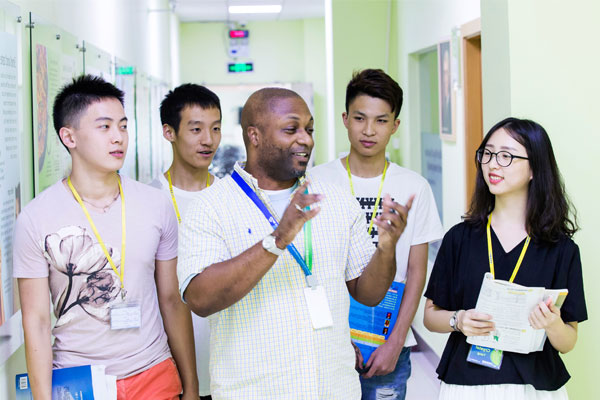The Importance of a Simple Water Pump
This is the VOA Special English Development Report.
A simple water pump is helping to improve the lives of poor families in several Asian and African countries.
A farmer in Bangladesh using a treadle pump to grow vegetables
A treadle pump in vegetable fields in Bangladesh
The treadle pump is based on a design developed in the nineteen seventies by Norwegian engineer Gunnar Barnes. It can be made locally. A group based in the United States, IDE, International Development Enterprises, has created programs in different countries.
The program in India won an Ashden Award in two thousand six for using local sources of energy to improve quality of life. Last year the Bill and Melinda Gates Foundation awarded IDE twenty-seven million dollars. The money is to be used to expand small irrigation projects to the other half of India's twenty-eight states.
The treadle pump is easy to build from bamboo or other wood and two metal cylinders with pistons. The pistons go up and down as a person stands on lever devices -- treadles -- and uses a natural walking motion.
How many hours a day the pump needs to be operated depends on the season and how much water is needed for crops. It could be two hours a day. It could be seven hours a day.
Small children sometimes stand with their parents on the treadles. Everyone in the family can take turns operating the pump.
The Acumen Fund is a nonprofit group that invests in business projects to fight poverty. It studied the effects of treadle pumps in the Indian state of Uttar Pradesh. Uttar Pradesh has three treadle pump manufacturers and more than seventy-three thousand pumps.
Acumen reported that families using them ate more vegetables, because they were able to grow more to eat and to sell. Many of these families also drank more milk, because they bought a cow with their added earnings. Men with treadle pumps often no longer have to leave the farm to seek extra work in cities.
The pumps can also improve education. Farmers often use their extra earnings to buy books for their children or to pay for schooling.
A farmer in Zambia said he hoped to have enough money in three years to buy a diesel-powered pump. Then he could grow more crops over a larger area.
But the world economic crisis has had an effect on some farmers. IDE executive director Zenia Tata says some who were able to buy diesel pumps now do not enough money to buy fuel. So they are using their treadle pumps again.
And that's the VOA Special English Development Report, written by Karen Leggett.
一个简单的抽水机可以帮助改善一些亚洲和非洲国家贫穷家庭的生活。
踏板抽水机是基于上世纪70年代挪威工程师Gunnar Barnes的设计发明的,可以在当地制造。位于美国的国际发展企业(International Development Enterprises,IDE)在不同的国家都设有项目。
在印度设立的项目因利用当地能源改善居民生活质量而荣获2006年的艾希顿奖。去年,比尔与梅林达·盖茨基金会( Bill & Melinda Gates Foundation)奖励给国际发展企业2700万美元。这笔资金将用于在印度其他28个州拓展小型灌溉项目。
踏板抽水机很容易制造,用竹子或其它木材,加两个有活塞的气缸就可以了。人站在杠杆设施——踏板上来回走动时,活塞就会上下移动。
抽水机每天需要工作多久取决于季节以及作物需水量。可以是每天两小时,也可以是每天七小时。
小孩子有时会和父母一起站在踏板上。家庭中的每个人可以轮流操作这种抽水机。
纽约商机基金(Acumen Fund)是一个非营利组织,主要投资于对抗贫穷的商业项目。该组织在印度的Uttar Pradesh研究了踏板抽水机的影响。Uttar Pradesh拥有三家踏板抽水机制造商,7.3万多部抽水机。
据纽约商机基金报道,印度家庭可以食用更多蔬菜,因为通过使用踏板抽水机,他们能够种植更多,食用更多,甚至可以拿到市场上出售。许多家庭还可以饮用更多牛奶,因为他们可以利用增加的收入购买奶牛。拥有踏板抽水机的人们不再需要离开农田到城市里打工。
这些抽水机还有助于改善教育水平。农民经常利用额外收入为孩子购买书籍,或者支付学校费用。
赞比亚一位农民说,他希望三年之内有钱购买一台柴油抽水机。这样他就能在更大的区域内种植更多的作物。
但是世界经济危机对一些农民造成了影响。国际发展企业执行理事Zenia Tata说,有能力购买柴油抽水机的人现在却没有足够的钱来购买燃料。所以他们重新使用踏板抽水机。

